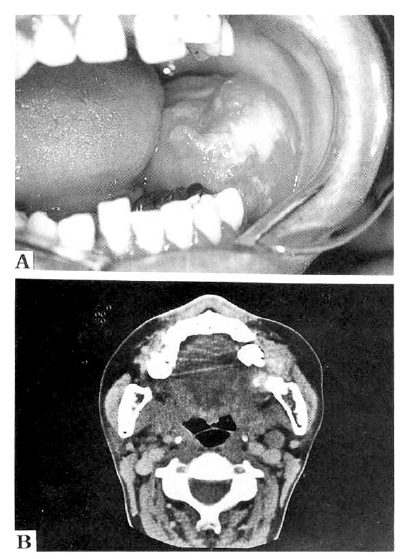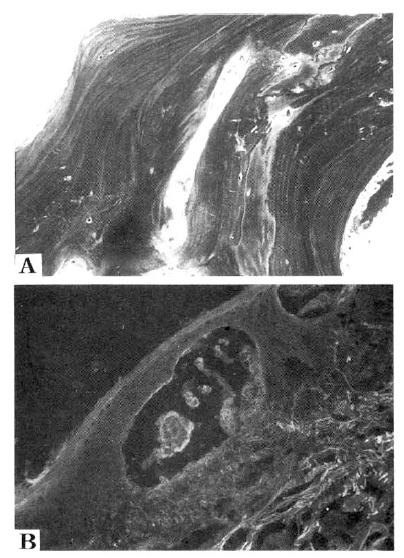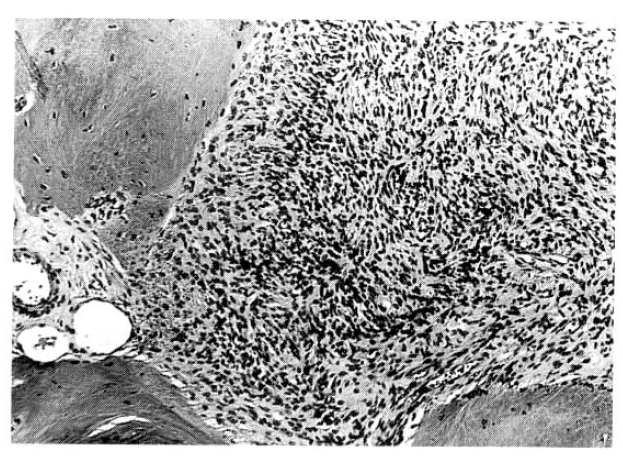Oncogenic Osteomalacia Caused by a Phosphaturic Mesenchymal Tumor of the Oral Cavity: A Case Report
Article information
Abstract
We report a case of oncogenic osteomalacia associated with a phosphaturic mesenchymal tumor in a 31-year-old woman. She was presented with severe generalized bone and muscle pain and was restricted to bed. She lost 20cm in height over the 8 years since she had first noticed a pain in her thigh. A walnut-sized, hard, soft tissue tumor was found very easily beside her lower molar teeth. Radiologic examination revealed a remarkable decrease in bone density and multiple pathologic fractures of spine, femur and phalangeal bones. Severe hypophosphatemia, hyperphosphaturia, low plasma 1,25-dihydroxyvitamin D3 level and high plasma PTH level were disclosed at presentation. Histomorphometric examination revealed an extensive area of unmineralized osteoid and little mineralizing activity. A pharmacologic dose of 1α-hydroxyvitamin D3 or 1,25-dihydroxyvitamin D3 slightly increased the serum phosphate level and renal tubular reabsorption of phosphate, and slightly decreased plasma PTH level without any symptomatic improvement. Histologic examination of the tumor revealed a mixed connective tissue tumor that consisted of central woveh bones and surrounding primitive spindle cells with prominent vascularities. After removal of the tumor, all biochemical, hormonal and radiologic abnormalities disappeared with remarkable symptomatic improvement.
INTRODUCTION
Oncogenic or tumor-induced osteomalacia is a syndrome characterized by osteomalacia and is associated with hyperphosphaturia, hypophosphatemia and low plasma 1,25-dihydroxyvitamin D, concentrations, which disappear when the tumor is removed. Just over 80 cases, with a variety of tumors, have been reported since 19591, 2). Although considered rare, this syndrome may be more common than is appreciated. In addition, the syndrome often persists unrecognized for many years before the tumor is discovered and removed. Failure to recognize this syndrome is the consequence of two factors. First, the tumors are frequently small and in peculiar locations. Second, many clinicians and pathologists are not aware of this peculiar paraneoplastic syndrome3).
The tumor can be either benign or malignant and can be of one among endodermal, mesodermal and epidermal origin1). The mesenchymal tumors, associated with the large majority of patients, have been variably described by different names. As the specific cell type or phosphaturic substance has not been characterized, it is recommended to use a descriptive phrase, phosphaturic mesenchymal tumor, to label these tumors. The histologically polymorphous mesenchymal tumors can be subdivided into four distinct morphologic patterns: primitive-appearing, mixed connective tissue tumors; osteoblastoma-like tumors; non-ossifying fibroma-like tumors; ossifying fibroma-like tumors4). To our knowledge, there is no report of a mixed connective tissue tumor found in the oral cavity. We report a case of oncogenic osteomalacia associated with mixed connective tissue tumor which was found very easily beside the lower molar teeth and cured by surgical resection, and we describe the changes of the various biochemical, hormonal and radiological findings regarding bone turnover before and after surgery on the patient.
CASE REPORT
1. Case History and the Laboratory Findings
A 31-year-old housewife was presented with an eight-year history of generalized bone and muscle pain. Ten years ago, she noticed a tingling pain in her right thigh and was diagnosed, at a private clinic, as having a herniation of an intervertebral disk. The pain became progressively worse without any relief from physiotherapy and analgesics. She was transferred to a university hospital, where the diagnosis of primary hyperparathyroidism was made as the radiologic examination revealed osteopenia and the serum phosphorus was 2.1 mg/dL (normal range 3.0–4.5), alkaline phosphatase 453IU/L (normal range 30–120) and plasma PTH (middle molecule) 211pmol/L (normal range 24–72). However, her serum calcium concentration was only 9.0mg/dL (normal range 9.0–10.5) and no tumor was found in the parathyroid glands. She was discharged without operation but suffered from severe back pain thereafter and lost 13cm in height during the period of one year. She was on sodium phosphate, 3g/day, for five months without any clinical improvement. She visited another hospital as she could not walk due to the severe back pain. Serum calcium concentration was 9.2 mg/dL, phosphorus 1.6mg/dL, tubular reabsorption of phosphate (TRP) 73% (normal range 79–94), alkaline phosphatase 350IU/L and PTH (middle molecule) 325pmol/L. Bone scan showed multiple increased uptake of radioisotope on the ribs and bone biopsy revealed severe osteomalacia. She was diagnosed as X-linked hypophosphatemic ricket. Sodium phosphate and 1,25-dihydroxy-vitamin D had been prescribed for three years, but could not improve either the symptoms or the laboratory findings. She lost 7 cm more in height during the period. Neither acupuncture nor herb medications could help her. She finally became restricted to bed one year prior to admission to our hospital. She was free of any other disease history and family disease history. She had been off medication for six months before admission to our hospital.
On examination, she was only 138cm in height and 28kg in weight. The muscles of her extremities were very emaciated and she complained of severe tenderness in her muscles. She could not sit by herself and not even stretch her legs in the bed because of severe back pain. At the beginning of the physical examination, a walnut-sized, pinkish, hard, round, protruded mass was found on the lateral side of the left lower molar teeth (Fig. 1A). The initial clinical investigations were as follows: serum calcium 8.7mg/dL, phosphorus 0.9mg/dL, alkaline phosphatase 528IU/L, osteocalcin 8.84 ng/mL (normal range 1.8–6.6), TRP 70%, PTH (middle molecule) 180pmol/L, calcitonin 34.4pg/mL (normal range < 50pg/mL), 25-hydroxyvitamin D3 25.6ng/mL (normal range 10–76), 1,25-dihydroxyvit amin D3 8.1pg/mL (normal range 16.4–42.4). Urinalysis revealed neither glycosuria nor proteinuria.

(A) Intraoral view of the left side of the mandible. Note buccal expansion of the tumor witn pinkish yellow surface. (B) Computerized tomography finding of the tumor. Note the soft tissue mass protruding from the middle portion of the left mandible.
Radiologic examination of the skeletal system disclosed severe osteopenia. Most of the vertebral bones were severely demineralized and collapsed, resulting in severe scoliosis and shortening of the distance between the lower anterior costal margin and the iliac crest. The right femur was found to have a fracture in its neck with marked thinning of the cortical bone. Multiple pathologic fractures of the phalangeal bones of both hands were revealed without any callus formation. The iliac bone was obtained for bone histomorphometry. The section of the undecalcified bone demonstrated a small amount of mineralized bone surrounded, by a large amount of unmineralized osteoid (Fig. 2A). Tetracycline labelling showed little labelling throughout the whole mineralization fronts, suggesting very severe mineralization defect (Fig. 2B).

Histologic sections of the iliac bone biopsy specimen. (A) Light microscopic examination (Goldner’s modified Masson’s trichrome stain, ×100) demonstrating a small amount of mineralized bone surrounded by a large amount of unmineralized osteoid. (B) Fluorescent microscopic examination showing little tetracycline labelling throughout the whole mineralization fronts.
The computerized tomography of the oral cavity tumor revealed an ovoid heterogenous mass protruding from the ramus of the left mandible (Fig. 1B). Sonography and a thallium subtraction scan of the parathyroid gland revealed no tumor. A bone scan, using 99mTc-methylene diphosphonate (MDP), showed a remarkably increased uptake in the skull, ribs, spine, iliac bones, shoulders, elbows, wrists and ankles. Bone mineral density, measured by dual energy X-ray absorptiometry (DPX-L bone densitometry, Lunar, USA), revealed 0.468g/cm2 in the spine (normal range 1.133±0.085), 0.368 in the legs (normal range 1.089±0.074) and 0.411 in the arms (normal range 0.78±70.047).
2. Clinical Course and Endocrine Profiles
The patient’s history and our laboratory findings prompted us to suspect oncogenic osteomalacia caused by the tumor found in the oral cavity. However, medical treatment with oral phosphate and vitamin D3, in the form of either 1α-hydroxyvitamin D3 or 1,25-dihydroxyvitamin D3, was tried for 5 weeks before removal of the tumor. 1α-hydroxyvitamin D3 (Onealfa, Teijin Ltd., Japan) was administered orally at a daily dose of 20μg for 3 weeks with 3.0g of daily oral sodium phosphate for a week, and then she was off all medications for a week. 1,25-dihydroxyvitamin D3 (Rocaltrol, Roche, Switzerland) was given orally again at a daily dose of 10μg for two weeks without any symptomatic improvement. During the treatment, serum phosphorus concentration and TRP remained below the normal range, whereas the concentration of serum calcium increased (Fig. 3A, B). While serum alkaline phosphatase activity did not change significantly, serum osteocalcin concentration increased (Fig. 3C, D). The concentration of plasma 25-hydroxyvitamin D3 remained in the normal range and the level of plasma 1,25-dihydroxyvitamin D3 increased transiently only after administration of 1,25-dihydroxyvitamin D3 (Fig. 3E, F). The plasma PTH concentration decreased to the upper limit of the normal range (Fig. 3G), but the levels of serum calcitonin (Fig. 3H) remained in the normal range without any significant changes. One week after the en bloc resection of the tumor, the patient admitted less bone and muscular pain. The serum phosphorus concentration did not increase and TRP decreased again to the level observed before 1,25-dihydroxyvitamin D3 treatment. (Fig. 3A, B). Both of the serum alkaline phosphatase activity and serum osteocalcin level dropped sharply (Fig. 3C, D), but the plasma 1,25-dihydroxyvitamin D3 level slightly increased (Fig. 3F). A bone scan disclosed reduced radioisotope uptake in general, compared with the preoperative findings. Two weeks after the surgery, the patient complained about bone pain again without muscular pain, but was able to stretch her legs. The levels of serum phosphorus and TRP increased to the normal range.

Changes of the biochemical and hormonal changes during the preoperative period of medical treatment and the postoperative period.
The plasma 1,25-dihydroxyvitamin D3 concentration steadily increased until the third postoperative week, whereas the plasma 25-hydroxyvitamin D3 level remained in the normal range (Fig. 3E, F). The plasma PTH concentration transiently increased for four weeks after removal of the tumor (Fig. 3G). The patient could sit on the bed by herself at the fourth postoperative week. Bone scan showed increased radiotracer uptake again, which was comparable with the preoperative findings. Bone densitometry revealed remarkable increase in bone mineral density, 27% in spine, 11% in the proximal femur and 4% in the proximal humerus. Radiologic examination disclosed callus formations around the previous fracture sites of the phalangeal bones. The patient was discharged, walking with crutches, at the fifth postoperative week.
3. Histopathology
The largest diameter of the resected specimen measured 2.5cm. The cut surface of the tumor showed a gray-white and firm appearance with scattered calcification. Microscopically, the tumor consisted of central woven bones with surrounding primitive spindle cells. The primitive spindle cells were arranged in fasicle patterns. The individual tumor cells had ovoid-to spindle-shaped nuclei with a fine chromatin pattern and a scanty amount of cytoplasm. In some areas, there were prominent vascularities and some foci of fibrous lesion composed of spindle cells disposed in whorled storiform patterns (Fig. 4).
DISCUSSION
The mixed connective tissue tumor is the most common type in oncogenic osteomalacia4). The tumor in our case shows the characteristics of a primitive-appearing mixed connective tissue tumor.
The detection of the small, innocuous tumor, giving rise to the syndrome, is often difficult. In this case, however, the tumor was very easy to find during a routine physical examination. A previous report presented a young male patient with oncogenic osteomalacia caused by a tumor arising from the left side of the mandible, which was also found in the oral cavity5). In the present case, however, the tumor is not believed to have originated in the mandible since it was clearly separated from the bone, although it destroyed some alveolar bones. Furthermore, the incisional biopsy in the previous case revealed a soft brown tissue mass which was histologically diagnosed to be of giant cell variety. These findings suggest that the previous case is quite different from the present case.
The pathophysiological basis for oncogenic osteomalacia remains unknown. Nevertheless, most investigators agree that tumor production of a humoral factor (s) that may affect multiple functions of the proximal tubule6–8) is the probable pathogenesis of the syndrome. It was demonstrated that 25-hydroxyvitamin D-1-α-hydroxylase activity in cultured renal tubular cells was decreased by incubating the cells with tumor extracts9). It suggests that a substance (s) produced by the tumor inhibits the formation of 1,25-dihydroxyvitamin D3 in the mitochondria of the proximal tubule, which could be a factor contributing to the pathogenesis of oncogenic osteomalacia. Although severe hypophosphatemia and elevated PTH level in our case should be the strong stimuli for renal 1,25-dihydroxyvitamin D3 synthesis, plasma concentration of 1,25-dihydroxyvitamin D3 was low before surgery. After removal of the tumor, the plasma 1,25-dihydroxyvitamin D3 level immediately increased. These findings suggest that a humoral substance (s), secreted from the tumor, inhibits the formation of 1,25-dihydroxyvitamin D3. In fact, striking improvement of the biochemical and bone abnormalities of the syndrome, in response to a daily dose of 2–3μg of 1,25-dihydroxyvitamin D3 has been reported8, 10).
However, in many patients, symptoms and/or renal phosphate handling improve only partially, or not at all, despite therapy with 1,25-dihydroxyvitamin D3 or the related 1-hydroxyvitamin D37, 11–13). Therefore, 1,25-dihydroxyvitamin D3 deficiency alone does not explain the hyperphosphaturia of the syndrome. In our case, a much larger dose of 1,25-dihydroxyvitamin D3 (10μg) only slightly restored TRP and decreased the PTH level without any improvement in symptoms and serum phosphate concentration. These findings suggest that the inhibition of 1,25-dihydroxyvitamin D3 formation by a humoral substance (s) is not a major defect in our case. Therefore, our data support the recent in vitro observation of Cai et al.14). They demonstrated that the culture medium of a sclerosing hemangioma associated with oncogenic osteomalacia directly inhibited the sodium-dependent phosphate transport in the cultured opossum kidney epithelial cells. It, however, can not be excluded that the renal tubular disturbances caused by a tumor-derived substance (s) may vary between tumors. In fact, other abnormalities of the proximal renal tubular function, such as aminoaciduria and glycosuria, have also been encountered in some cases7, 8, 15).
Parathyroid hyperfunction has been documented in many cases with oncogenic osteomalacia9, 16, 17). Elevated plasma PTH level, in spite of severe hypophosphatemia, suggests at least two possibilities. Firstly, a humoral substance released from the tumor may stimulate PTH secretion. Secondly, positive feedback on PTH secretion by the low level of 1,25-dihydroxyvitamin D3 overwhelms the inhibition by hypophosphatemia. In fact, plasma PTH levels decreased after tumor removal, which supports the possibility. The postoperative increase in 1,25-dihydroxyvitamin D3 is thought to decrease plasma PTH level either by enhancing gastrointestinal calcium absorption or inhibiting PTH secretion directly18). For two weeks after tumor removal, the plasma PTH level increased again. It may reflect a period for the parathyroid gland, that has been hyperfunctioning, to reset its threshold for the increased serum phosphorus concentration.
Interestingly, both serum alkaline phosphatase activity and osteocalcin level decreased transiently during the same period. Reduction of bone resorption demand after tumor removal is thought to reduce compensatory osteoblastic activity during the period. In accordance with the finding, bone scan also showed decreased radiotracer uptake at the first postoperative week compared with the preoperative findings. Three weeks later, bone scan showed generalized increased radiotracer uptake again. A recent report also demonstrated multiple foci of osteoblastic lesions and diffusely increased calvarial activity even 4 months after removal of the tumor19).
During 1,25-dihydroxyvitamin D3 treatment, serum alkaline phosphatase activity also slightly decreased, suggesting that bone-forming osteoblast activity slightly decreased by partial reduction of the bone resorption demand. In contrast, the concentration of serum osteocalcin increased during the vitamin D3 treatment. It is compatible with the previous report that the osteocalcin gene has the vitamin D-response element and its transcription is activated by 1,25-dihydroxyvitamin D320). The expression of the alkaline phosphatase gene, however, does not seem to be regulated by 1,25-dihydroxyvitamin D3.
Earlier reports demonstrated little changes18) or increase9) in bone mineral density, 3 months and 8 months respectively, after removal of tumors. In our case, bone mineral density remarkably increased even one month after the operation. Callus formation was also clearly seen around the previous non-union sites, suggesting increased bone mineralization.
Acknowledgments
This study was supported by the Clinical Research Grant of the Endocrine Research Institute at Kyunghee University Medical Center. We are grateful to Peter Khang and Liam McCarron for the preparation of this manuscript.
